- Mini Review
- Abstract
- Introduction
- Electromagnetic Wave and Spectrum
- Sources of EM Radiation
- Consequences of Electromagnetic Interference (EMI)
- International Efforts
- Shielding Against Electromagnetic Radiations
- Materials Used and Selection Criteria
- Introducing Magnesium
- Electromagnetic Shielding Capability of Magnesium-Comparison
- Concluding Remarks
- References
The Promise of Magnesium Based Materials in Electromagnetic Shielding
Manoj Gupta1* and Shwetabh Gupta2
1Department of Mechanical Engineering, National University of Singapore, Singapore 225 Dover Cl E, Singapore
Submission: August 10, 2017; Published: September 14, 2017
*Corresponding author: Manoj Gupta, Department of Mechanical Engineering, National University of Singapore9 Engineering Drive 1, Singapore 117 576, Singapore, Email: mpegm@nus.edu.sg
How to cite this article: Manoj G Shwetabh G. The Promise of Magnesium Based Materials in Electromagnetic Shielding. JOJ Material Sci. 2017; 2(5): 555598. DOI:10.19080/JOJMS.2017.02.555598
- Mini Review
- Abstract
- Introduction
- Electromagnetic Wave and Spectrum
- Sources of EM Radiation
- Consequences of Electromagnetic Interference (EMI)
- International Efforts
- Shielding Against Electromagnetic Radiations
- Materials Used and Selection Criteria
- Introducing Magnesium
- Electromagnetic Shielding Capability of Magnesium-Comparison
- Concluding Remarks
- References
Abstract
Electromagnetic pollution is emerging as one of most dominant pollution in recent times largely due to the widespread use of electronics equipment ranging from the personal use, societal benefits to modern warfare. Also known as electromagnetic smog, this pollution is not only capable to disrupt the existing systems but can also affect the human health adversely. Accordingly, it is becoming important to progress in this area through developing and designing materials and promoting technologies that are superior to the one currently used for shielding electromagnetic waves. The aim of this paper is to introduce readers to electromagnetic radiation threats and the current materials science that is used to mitigate these effects.
- Mini Review
- Abstract
- Introduction
- Electromagnetic Wave and Spectrum
- Sources of EM Radiation
- Consequences of Electromagnetic Interference (EMI)
- International Efforts
- Shielding Against Electromagnetic Radiations
- Materials Used and Selection Criteria
- Introducing Magnesium
- Electromagnetic Shielding Capability of Magnesium-Comparison
- Concluding Remarks
- References
Introduction
Electro smog (e-smog) or electromagnetic pollution has increased tremendously in recent years due to ever increasing use of electronic gadgets. Accordingly, it is not surprising that electromagnetic pollution has emerged as fifth largest pollution after noise, water, air and solid waste pollutions [1]. For example, our exposure to electromagnetic radiation is millions of times more than 50 years ago putting us at a much higher health risk than our previous generations [2]. Shielding materials are thus required so that electromagnetic interference (EMI) is neither able to disrupt critical devices, equipment, and systems (such as medical, military and aerospace electronics) nor it is able to cause catastrophic health effects on users [3].
- Mini Review
- Abstract
- Introduction
- Electromagnetic Wave and Spectrum
- Sources of EM Radiation
- Consequences of Electromagnetic Interference (EMI)
- International Efforts
- Shielding Against Electromagnetic Radiations
- Materials Used and Selection Criteria
- Introducing Magnesium
- Electromagnetic Shielding Capability of Magnesium-Comparison
- Concluding Remarks
- References
Electromagnetic Wave and Spectrum
An electromagnetic wave (radio waves, microwaves, infrared, ultraviolet, X-rays and gamma rays) consists of electric and magnetic components. These electric and magnetic fields are always in phase and at 90 degrees to each other (Figure 1) [4]. Electromagnetic waves can travel in vacuum and at the speed of light. A typical electromagnetic spectrum is shown in Figure 2 [4]. Electromagnetic radiation can broadly be categorized into two types:
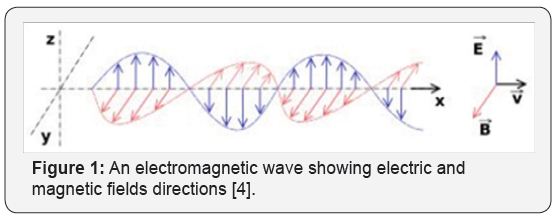
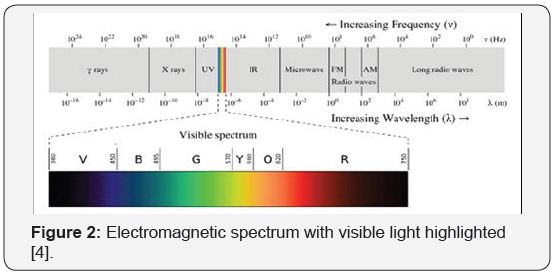
Ionizing radiation: Examples, far UV rays, x-rays and gamma rays (can damage DNAs). The photons of these rays have enough energy to break chemical bonds (Table 1) [5, 6].

Non-ionizing radiation: The photons do not have enough energy to ionize atoms or molecules. Such radiations are capable of heating living tissue through energy transfer by photons. Examples are visible light, infrared, microwaves, and radio waves.
- Mini Review
- Abstract
- Introduction
- Electromagnetic Wave and Spectrum
- Sources of EM Radiation
- Consequences of Electromagnetic Interference (EMI)
- International Efforts
- Shielding Against Electromagnetic Radiations
- Materials Used and Selection Criteria
- Introducing Magnesium
- Electromagnetic Shielding Capability of Magnesium-Comparison
- Concluding Remarks
- References
Sources of EM Radiation
Major sources of electromagnetic radiations include [7]:
a. Natural Sources: Electric storm (of frequency ~10MHz); solar radiations (of frequency~10MHz)
b. Artificial Sources: Manmade sources.
All electrical equipment radiate electromagnetic fields. Table 2 shows the sources of electromagnetic radiations and our susceptibility to their exposure irrespective of whether we are at home, in the office or in the city [5,8].
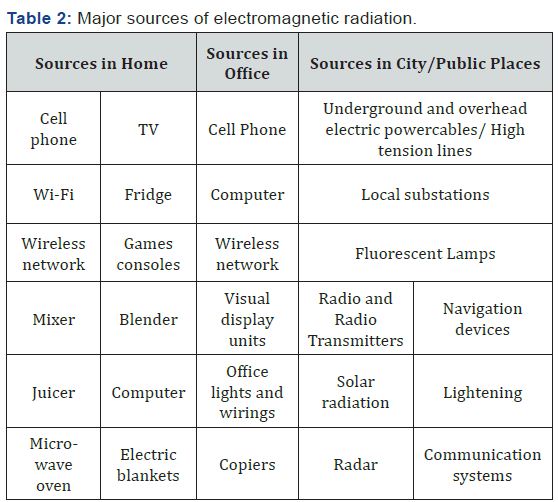
- Mini Review
- Abstract
- Introduction
- Electromagnetic Wave and Spectrum
- Sources of EM Radiation
- Consequences of Electromagnetic Interference (EMI)
- International Efforts
- Shielding Against Electromagnetic Radiations
- Materials Used and Selection Criteria
- Introducing Magnesium
- Electromagnetic Shielding Capability of Magnesium-Comparison
- Concluding Remarks
- References
Consequences of Electromagnetic Interference (EMI)
On systems and equipment functioning
EMI, if not controlled can cause [9]:
- Disruption in railroad and mass transit system.
- Disruption in vehicular control system.
- Disruption in the functioning of medical equipment that includes life support devices, x-ray machines, electrical and electronic equipment in surgical units, patient telemetry and assistance.
- Compromises in military warfare.
On health and living organisms
The study of interactions between EM radiations with living organisms is known as Bio electro magnetics. Human beings usually operate at frequencies between 2-12Hz. Normal household current is 50-60 Hz and is thus incompatible and disruptive to body’s natural electric frequency regime, neural transmission system and its sensitive neuro-chemical equilibrium [10]. It is thus not surprising that exposure to electromagnetic radiations can lead to adverse health effects. Magnetic fields associated with electromagnetic radiations can induce electric currents in bio-systems including humans, animals, and plants leading to adverse effects on metabolism and hormone productions. This is because electromagnetic alternating fields are many times stronger than body currents and thus body fails at many times to trigger its own adequate compensation mechanisms leading to weakness, sickness, and diseases [3]. Some adverse health effects that are linked to exposure to electromagnetic radiation include [3,10]:
- Unusual neurological functions such as dementia, chronic fatigue, and fibromyalgia,
- Cancer including leukemia.
- Hypertension.
- Alzheimeir’s disease.
- Headaches.
- Parkinson’s disease.
- Cardiovascular problems (heart and blood vessels).
- Rheumatoid arthritis.
- Effect of eyes including cataracts.
- Metabolic changes in tissues.
- Changes in the immune system.
- Adverse effects on male (reduced sperm count and sexual drive) and female reproductive systems (such as disruption of the menstrual cycle).
It has also been cited that exposure to electromagnetic radiations has a cumulative effect increasing over time and with dose [3,10,11].
- Mini Review
- Abstract
- Introduction
- Electromagnetic Wave and Spectrum
- Sources of EM Radiation
- Consequences of Electromagnetic Interference (EMI)
- International Efforts
- Shielding Against Electromagnetic Radiations
- Materials Used and Selection Criteria
- Introducing Magnesium
- Electromagnetic Shielding Capability of Magnesium-Comparison
- Concluding Remarks
- References
International Efforts
In view of EM threat, many countries in the world including the European Union are taking initiatives to ensure protectionagainst the electromagnetic radiations from as early as 1989 (Electromagnetic Compatibility Directive-Council Directive 89/336/EEC) [7]. NATO recommends electromagnetic shielding for computers and keyboards to mitigate monitoring of keyboard emissions that can allow the passwords to be captured [12,13]. The World Health Organization (WHO) has classified radio frequency electromagnetic radiation as Group 2B - possibly carcinogenic [4,14].
This group contains possible carcinogens that have weaker evidence, at the same level as pickled vegetables and automobile exhaust. WHO also classified all UV frequencies as Group 1 carcinogens as they can directly or indirectly damage biological molecules. For example, ultraviolet radiation from sun exposure is the primary cause of skin cancer [4,15]. Sweden also, for example, lists electromagnetic field as Class 2 Carcinogens along with tobacco [16]. Besides several international authorities (such as International Commission on Non-ionizing Radiation) have also set safety limits for public and occupational EMF exposure to 50-60Hz [2].
- Mini Review
- Abstract
- Introduction
- Electromagnetic Wave and Spectrum
- Sources of EM Radiation
- Consequences of Electromagnetic Interference (EMI)
- International Efforts
- Shielding Against Electromagnetic Radiations
- Materials Used and Selection Criteria
- Introducing Magnesium
- Electromagnetic Shielding Capability of Magnesium-Comparison
- Concluding Remarks
- References
Shielding Against Electromagnetic Radiations
Shielding against EM waves is done through the use of conductive enclosures known as Faraday cages. Such cages are conductive in nature and often used in cables, mobile phones, and microwaves. Figure 3 shows such a cage used in a mobile phone. Such shielding prevents the escape of any signal from inside to outside and also prevents any signal to pass from outside to inside [13,17,18].
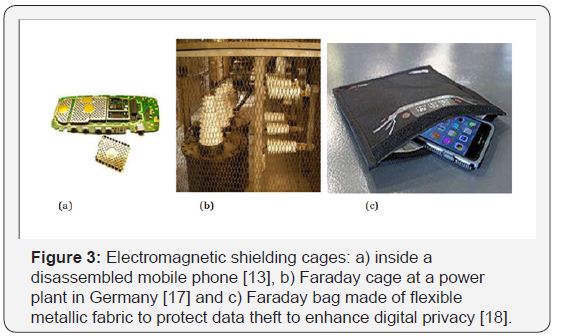
The mechanism includes cancelling the applied electric field and magnetic field by the conducting material that is used to avoid the leakage from inside to outside and outside to inside. Three mechanisms that attenuate electromagnetic waves are [19]:
- Absorption(A): Materials need high magnetic permeability.
- Reflection(R): Materials need high electrical conductivity.
- Multiple reflections(MR): Materials need a large surface or interface area.
The losses irrespective of above mechanisms are expressed in dB. The shielding effectiveness (SE) is the cumulative effect of the losses due to above three mechanisms.
SE = A + R + MR (1)
- Mini Review
- Abstract
- Introduction
- Electromagnetic Wave and Spectrum
- Sources of EM Radiation
- Consequences of Electromagnetic Interference (EMI)
- International Efforts
- Shielding Against Electromagnetic Radiations
- Materials Used and Selection Criteria
- Introducing Magnesium
- Electromagnetic Shielding Capability of Magnesium-Comparison
- Concluding Remarks
- References
Materials Used and Selection Criteria
The different materials used for electromagnetic shielding are listed in Table 3 along with their advantages/disadvantages.
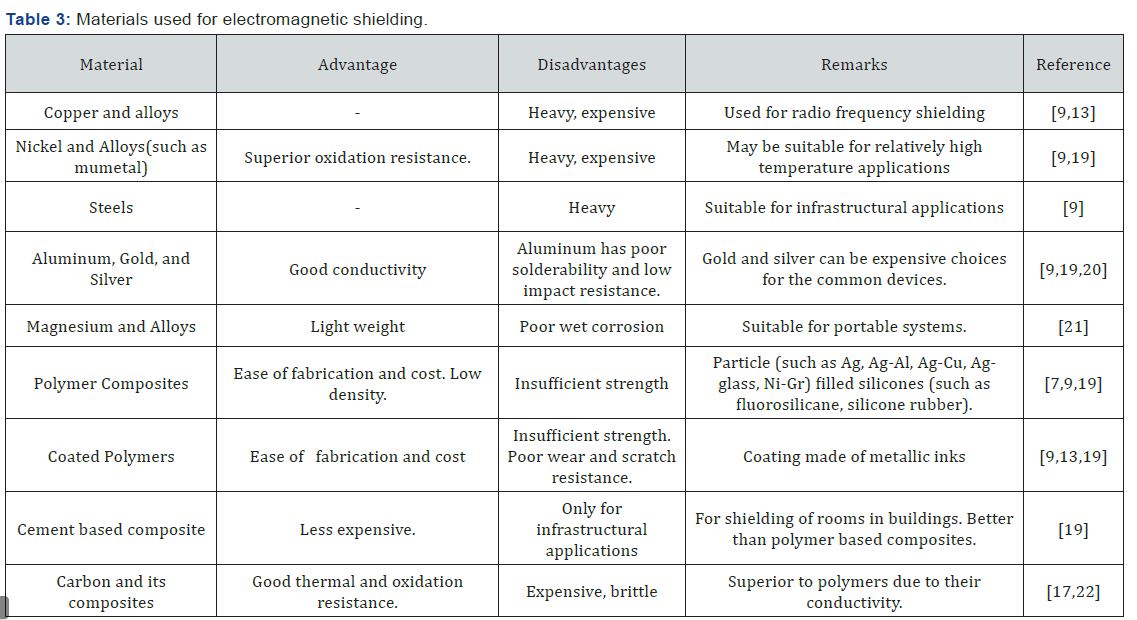
Table 3 indicates that metals and composites (metal based or plastic/ceramic based) can be used for electromagnetic shielding and their selection largely depends on [23]:
- End application.
- Cost factor.
- Performance level.
- Conductivity.
- Materials thickness.
- Corrosion.
- Application frequency.
Among these materials, magnesium is a strong choice as it exhibits good electrical conductivity and is the lightest of all metals. That makes it a strong choice in portable electronic devices due to weight factor and in defense sector where polymer based materials may not qualify due to their poor thermal capabilities.
- Mini Review
- Abstract
- Introduction
- Electromagnetic Wave and Spectrum
- Sources of EM Radiation
- Consequences of Electromagnetic Interference (EMI)
- International Efforts
- Shielding Against Electromagnetic Radiations
- Materials Used and Selection Criteria
- Introducing Magnesium
- Electromagnetic Shielding Capability of Magnesium-Comparison
- Concluding Remarks
- References
Introducing Magnesium
Magnesium is the lightest metallic element that can be used in a wide spectrum of engineering applications spanning from electronics to automobile to sports sectors [1]. Its abundance in planet earth (6th most available in earth crust and 3rd most available in the hydrosphere, 4th most abundant cation in the human body) makes it an extremely cost-efficient material. Some of the advantages of magnesium include [20]:
- Low energy requirement in solidification based processing.
- Ease of processing using conventional solid state methods.
- Applicability of conventional plastic deformation processes to realize complex shapes.
- Ease of recycling.
- Superior specific mechanical properties.
- Good machinability.
- Mini Review
- Abstract
- Introduction
- Electromagnetic Wave and Spectrum
- Sources of EM Radiation
- Consequences of Electromagnetic Interference (EMI)
- International Efforts
- Shielding Against Electromagnetic Radiations
- Materials Used and Selection Criteria
- Introducing Magnesium
- Electromagnetic Shielding Capability of Magnesium-Comparison
- Concluding Remarks
- References
Electromagnetic Shielding Capability of Magnesium-Comparison
Table 4 lists the electromagnetic shielding capabilities of magnesium, its alloys, and other materials. Table 4 clearly reveals the superiority of magnesium over that of aluminum. This is especially important as aluminum is currently most commonly used light weight material while magnesium is strongly emerging as its replacement due to its ability to provide additional ~33% weight saving at the component level. Magnesium like most other metals provides shielding primarily based on reflection mechanism. The weight saving benefit of magnesium extends over the full frequency spectrum [21]. For shielding based on absorption, die cast magnesium compares equally with aluminum in shielding effectiveness on an equal weight basis. It has been established that die cast magnesium alloy enclosures for EMI shielding are superior compared to both plastic and other metal housings [22]. An investigation into composites of magnesium also revealed that magnesium based syntactic composites provide similar shielding efficiency as that of aluminum composites while providing a much lighter weight (Table 4). The use of coated cenospheres in AZ91 matrix appeared to exhibit a less decline in SE with increasing frequency [23]. The use of reinforcement was attempted by researchers to add on the multiple reflection mechanisms in addition to reflection mechanism. The challenges include the formation of secondary phases and reduction in conductivity that adversely affect the reflection mechanism.
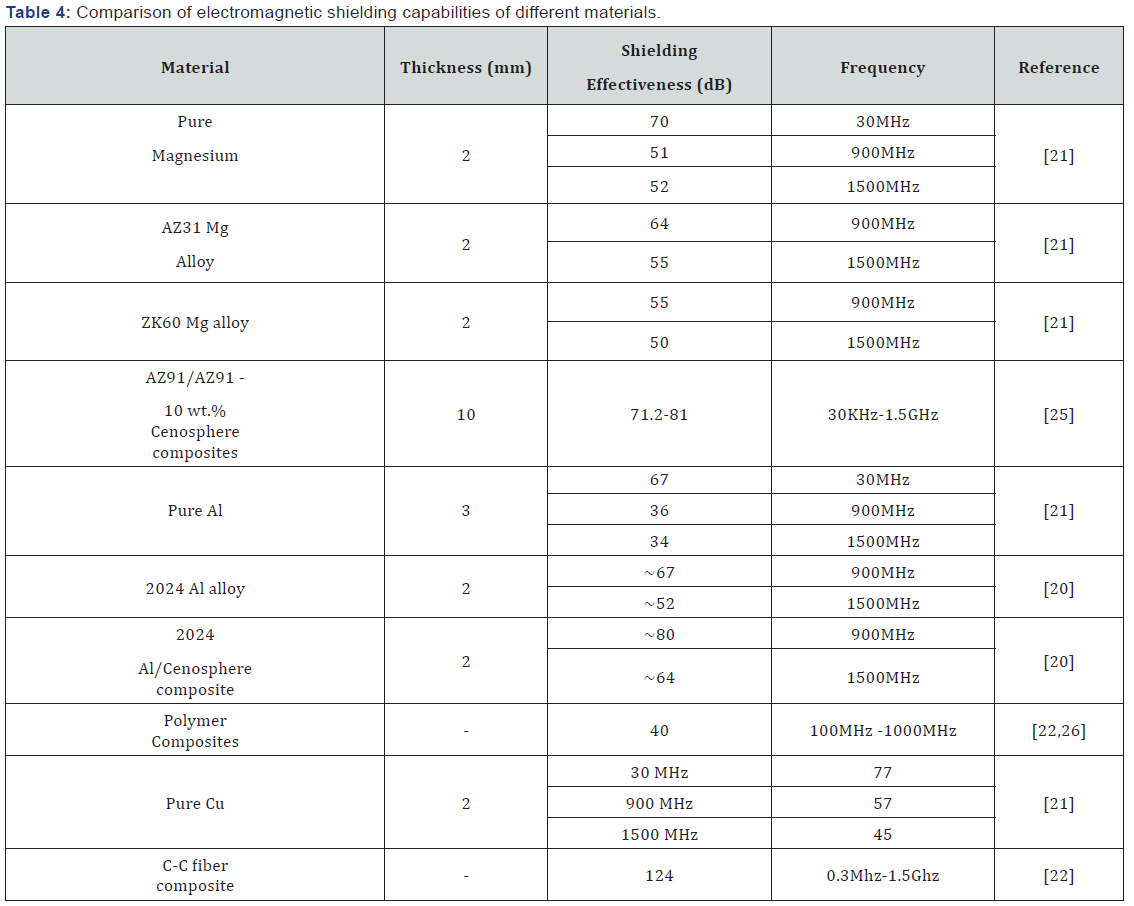
- Mini Review
- Abstract
- Introduction
- Electromagnetic Wave and Spectrum
- Sources of EM Radiation
- Consequences of Electromagnetic Interference (EMI)
- International Efforts
- Shielding Against Electromagnetic Radiations
- Materials Used and Selection Criteria
- Introducing Magnesium
- Electromagnetic Shielding Capability of Magnesium-Comparison
- Concluding Remarks
- References
Concluding Remarks
With a growing trend towards light weighting to reduce the fuel consumption and to enhance the human comfort (light weight laptops and portable devices), it is becoming important to design and use materials that are environment friendly and superior in performance when compared to conventional materials. Magnesium is a promising choice as it is the lightest metallic element and with inherently good electromagnetic shielding capabilities. However, the number of investigations done to improve the shielding effectiveness of magnesium is limited so far and much effort are required to develop magnesium based materials that are capable of invoking different mechanisms of shielding when in use. With sustained research efforts, shielding effectiveness of magnesium based materials can be raised to an excellent level which will assist in reducing electromagnetic pollution or smog and its adverse effects on living organisms including humans.
- Mini Review
- Abstract
- Introduction
- Electromagnetic Wave and Spectrum
- Sources of EM Radiation
- Consequences of Electromagnetic Interference (EMI)
- International Efforts
- Shielding Against Electromagnetic Radiations
- Materials Used and Selection Criteria
- Introducing Magnesium
- Electromagnetic Shielding Capability of Magnesium-Comparison
- Concluding Remarks
- References
References
- Jiang SX, Guo RH (2011) Surf Coat Tech 205: 4274-4279.
- Rifai AB, Hakami MA (2014) Health Hazards of Electromagnetic Radiation. J Bioscience and Medicines 2: 1-12.
- Valentina SE, Zizi RC, Elena C, Violeta A, Anca PA Latest Trends on Engineering Mechanics, Structures. Engineering Geology pp. 130-135.
- Hudson G Reducing Electromagnetic Radiation, e-bok.
- https://www.modusadvanced.com/resources/blog/what-is-emishielding- and-why-is-it-important-for-your-design
- http://www.alternative-magnetic-therapy.com/man-made-radiation. html
- WHO (2002) Department of Protection of the Human Environment, World Health Organization, Geneva, Switzerland (2002) Establishing a Dialogue on Risks from Electromagnetic Fields, Radiation and Environmental Health.
- https://lasec.epfl.ch/keyboard/
- https://en.wikipedia.org/wiki/Electromagnetic_shielding
- WHO (2011) IARC classifies Radiofrequency Electromagnetic Fields as possibly carcinogenic to humans. World Health Organization.
- Saladi RN, Persaud AN (2005) The causes of skin cancer: a comprehensive review. Drugs of today, Spain 41(1): 37-53. 77
- http://www.alternative-magnetic-therapy.com/electromagneticpollution. html
- https://commons.wikimedia.org/w/index.php?curid=2864574
- https://en.wikipedia.org/wiki/Faraday_cage
- Chung DDL (2000) Materials for electromagnetic interference shielding. Journal of Materials Engineering and Performance 9(3): 350-354.
- Wu G, Huang X, Dou Z, Chen S, Jiang L (2007) Electromagnetic interfering shielding of aluminum alloy–cenospheres composite. J Mater Sci 42: 2633-2636.
- Zhang Z, Pan F, Chen X, Liu J (2013) Electromagnetic Shielding Properties of Magnesium and Magnesium Alloys. J Mater Eng 3: 52-57.
- Geetha S, Satheesh Kumar KK, CRK Rao, Vijayan M, DC Trivedi (2009) EMI Shielding: Methods and materials-A Review. J App Polymer Sci 112: 2073-2086.
- https://leadertechinc.com/blog/the-three-most-popular-shieldingmetals- and-what-you-should-know-about-them/
- Magnesium, Magnesium Alloys and Magnesium Composites, M Gupta and Sharon Nai, John Wiley, 2011.
- Lu NN, Wang XJ, Meng LL, Ding C, Liu WQ, et al. (2015) Electromagnetic interference shielding effectiveness of magnesium alloy-fly ash composites, Journal of Alloys and Compounds 650: 871- 877.
- Trivedi DC (1997) In Handbook of Organic Conductive Molecules and Polymers. In: Nalwa HS (Ed.), Wiley, New York, USA 2: 505-572.
- EMI Shielding-NDC Quality Magnesium Castings.






























